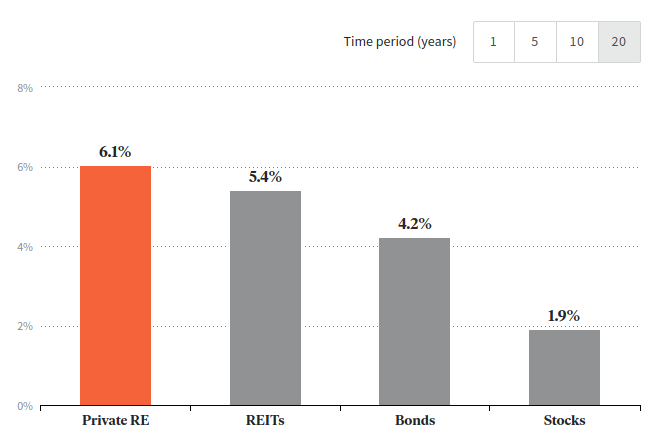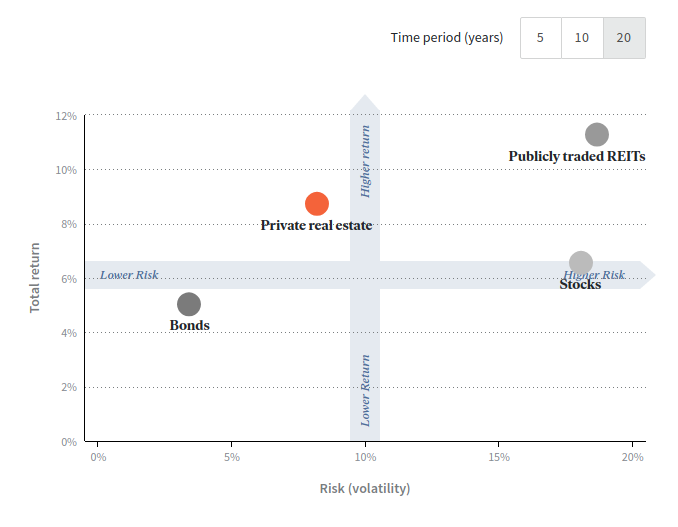
Private Real Estate
- Why Private Real Estate?
Private Real Estate
As an asset class, private real estate has historically offered a combination of attractive risk-adjusted returns with greater income and stability than stocks or publicly traded REITs.
Track record of client results
One of the most important questions to ask when evaluating a new investment advisor is “how have you performed for your existing clients?” With thousands of clients, and each with a wide range of objectives, the answer is more nuanced than a single number.
- Designed to harness the market’s potential
Investment strategies
By employing a combination of strategies, we aim to build well-rounded, resilient portfolios targeted to deliver consistently strong results based on our clients’ goals and appetite for risk.


Why Private Real Estate?
- Relative to a traditional portfolio composed of 60% large-cap stocks and 40% bonds, a portfolio which includes some allocation to private real estate has historically shown the ability to drive higher returns, with generally more annual income and lower volatility over the past 20 years. Learn how allocating 20-30% to private real estate could impact your portfolio.

- Income
Consistent historical income generation
Real estate has a well-earned reputation for being a reliable source of passive income. In fact, the income component of the NPI (the index that tracks private real estate performance), has averaged a higher rate than the yields of these other major asset classes
A balance of security with return potential
Of the four major asset types now readily available to online investors, private real estate generally mitigates risk while still prioritizing attractive returns, as shown here.
| Total Return | Volatility | Sharpe Ratio | |
|---|---|---|---|
| Stocks | 6.56% | 18.07% | 0.22 |
| Bonds | 5.03% | 3.43% | 0.74 |
| Publicly traded | 11.28% | 18.68% | 0.47 |
| Private real estate | 8.73% | 8.20% | 0.76 |


Bonds
Represented by the Bloomberg Barclays U.S. Aggregate Bond Index, a broad-based flagship benchmark that measures the investment grade, US dollar-denominated, fixed-rate taxable bond market. The index includes Treasuries, government-related and corporate securities, MBS (agency fixed-rate and hybrid ARM pass-throughs), ABS and CMBS (agency and non-agency).

Public REITs
Represented by the National Associate of Real Estate Investment Trusts (NAREIT) All REITs index, a market capitalization-weighted index that and includes all tax-qualified real estate investment trusts (REITs) that are listed on the New York Stock Exchange, the American Stock Exchange or the NASDAQ National Market List.

Private Real Estate
Represented by the National Associate of Real Estate Investment Trusts (NAREIT) All REITs index, a market capitalization-weighted index that and includes all tax-qualified real estate investment trusts (REITs) that are listed on the New York Stock Exchange, the American Stock Exchange or the NASDAQ National Market List.

Stocks
Represented by the S&P 500, an index of 500 stocks chosen for market size, liquidity and industry grouping, among other factors. The S&P 500 is designed to be a leading indicator of U.S. equities and is meant to reflect the risk/return characteristics of the large cap universe (Investopedia).
The benefits of investing in real estate
Income
Year after year, real estate has proven its ability to deliver superior income streams to investors.
Stability
While other types of investments zig and zag, real estate has a reputation for staying steady
Risk-adjusted Return
Managing your portfolio’s risk doesn’t need to mean sacrificing return potential.
Explore client performance over time
Annual returns of client accounts
In (Topview Homes)
| 2022 | 1.50% |
|---|---|
| 2021 | 22.99% |
| 2020 | 7.31% |
In (Public REITs)
| 2022 | -25.10% |
|---|---|
| 2021 | 39.88% |
| 2020 | -5.86% |
5% Referral Commission
We offer a very attractive affiliate program, which our members can use to earn more Profit by referring people to our system. An active deposit is not mandatory in order to get referral commissions. All you need is an account with us, and you’re ready to earn.
Join Now
Copyright © 2024 Topview Homes Limited.




